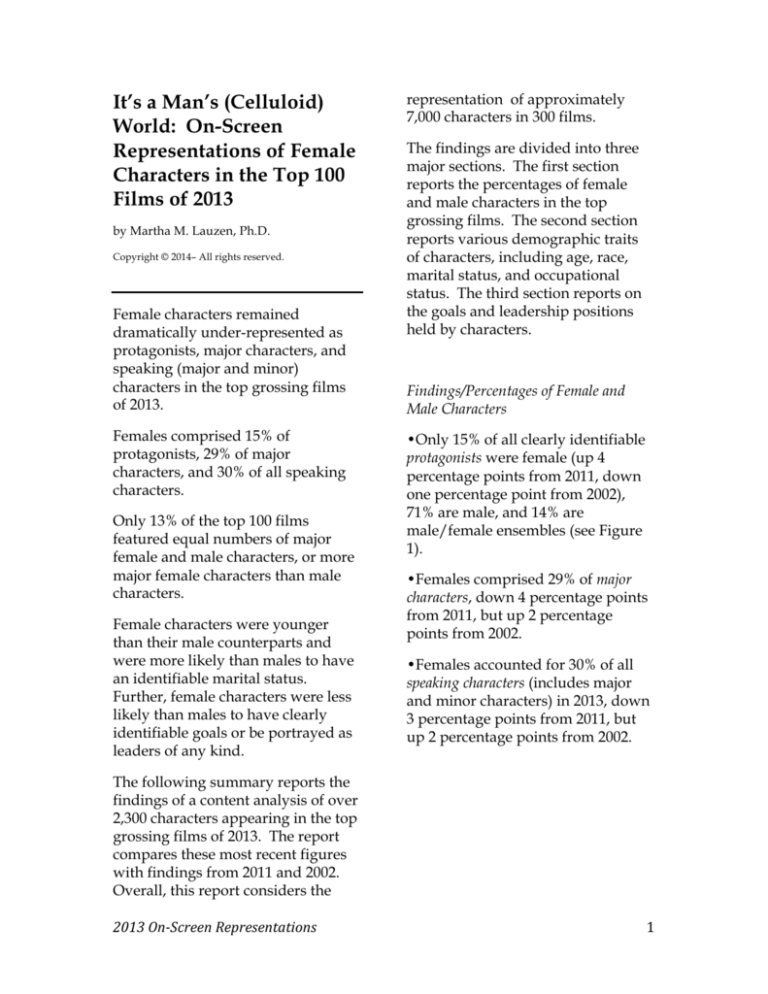
representation of approximately
7,000 characters in 300 films.
It’s a Man’s (Celluloid)
World: On-Screen
Representations of Female
Characters in the Top 100
Films of 2013
The findings are divided into three
major sections. The first section
reports the percentages of female
and male characters in the top
grossing films. The second section
reports various demographic traits
of characters, including age, race,
marital status, and occupational
status. The third section reports on
the goals and leadership positions
held by characters.
by Martha M. Lauzen, Ph.D.
Copyright © 2014– All rights reserved.
Female characters remained
dramatically under-represented as
protagonists, major characters, and
speaking (major and minor)
characters in the top grossing films
of 2013.
Findings/Percentages of Female and
Male Characters
Females comprised 15% of
protagonists, 29% of major
characters, and 30% of all speaking
characters.
•Only 15% of all clearly identifiable
protagonists were female (up 4
percentage points from 2011, down
one percentage point from 2002),
71% are male, and 14% are
male/female ensembles (see Figure
1).
Only 13% of the top 100 films
featured equal numbers of major
female and male characters, or more
major female characters than male
characters.
•Females comprised 29% of major
characters, down 4 percentage points
from 2011, but up 2 percentage
points from 2002.
Female characters were younger
than their male counterparts and
were more likely than males to have
an identifiable marital status.
Further, female characters were less
likely than males to have clearly
identifiable goals or be portrayed as
leaders of any kind.
•Females accounted for 30% of all
speaking characters (includes major
and minor characters) in 2013, down
3 percentage points from 2011, but
up 2 percentage points from 2002.
The following summary reports the
findings of a content analysis of over
2,300 characters appearing in the top
grossing films of 2013. The report
compares these most recent figures
with findings from 2011 and 2002.
Overall, this report considers the
2013 On-­‐Screen Representations 1 Figure 1.
were to see an Asian female
character.
Historical Comparison of Percentages of
Female and Male Characters as
Protagonists
•In 2013, the percentage of AfricanAmerican females rebounded to 14%
from 8% in 2011. For comparison,
African-American females accounted
for 15% of all female characters in
2002.
15 2013 85 11 2011 •The percentage of Latina characters
remained the same (5%) in 2013 as in
2011. This represents an increase of
1 percentage point since 2002 when
Latinas accounted for 4% of female
characters.
Females 89 Males 16 2002 •The percentage of Asian females
decreased 2 percentage points, from
5% in 2011 to 3% in 2013. Asians
also accounted for 3% of all females
in 2002.
84 0 50 100 •Female characters were more likely
than male characters to have an
identifiable marital status. 46% of
female characters but 58% of male
characters had an unknown marital
status.
Findings/Demographic Characteristics
•Female characters remain younger
than their male counterparts. The
majority of female characters were in
their 20s (26%) and 30s (28%). The
majority of male characters were in
their 30s (27%) and 40s (31%).
•A higher proportion of male than
female characters had an identifiable
occupational status. 78% of male
characters but only 60% of female
characters had an identifiable
job/occupation.
•Males 40 and over accounted for
55% of all male characters. Females
40 and over comprised 30% of all
female characters.
•When occupational status was
known, female characters were most
likely to hold blue collar positions
(37%), followed by white collar
positions (28%), out-of-workforce
positions such as students (19%), and
professional positions (9%).
•73% of all female characters were
Caucasian, followed by African
American (14%), Latina (5%), Asian
(3%), other worldly (3%), and other
(2%). Moviegoers were as likely to
see an other-worldly female as they
2013 On-­‐Screen Representations 2 Figure 2.
•A substantially larger portion of
male than female characters were
seen in their work setting actually
working (61% vs. 40%).
Comparison of Percentages of Female
and Male Characters as Leaders
Findings/Goals and Leadership
•Overall, 75% of speaking characters
had an identifiable goal. Of those
characters, a larger proportion of
male characters had an identifiable
goal (79%) than female characters
(67%).
97 11 Political 89 12 Criminal 88 Females •Male characters were much more
likely to have work-related goals
than personal life-related goals (75%
vs. 25%). In contrast, the goals of
female characters were split more
evenly between work-related and
personal life-related goals (48% vs.
52%).
86 16 White Collar 84 23 Social 77 0 •Broken down by type of leader,
males comprised 97% of blue-collar
leaders, 89% of political leaders, 88%
of criminal leaders, 86% of military
leaders, 84% of white-collar leaders,
and 77% of social leaders (see Figure
2).
Males 14 Military •Overall, 17% of characters were
leaders. Of those characters, a larger
proportion of male characters (21%)
than female characters (8%) were
portrayed as leaders.
2013 On-­‐Screen Representations 3 Blue Collar 50 100 Report compiled by Dr. Martha M. Lauzen,
Executive Director, Center for the Study of
Women in Television and Film, San Diego State
University, San Diego, CA 92182,
lauzen@mail.sdsu.edu
3








